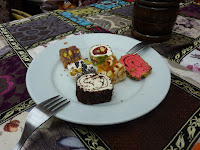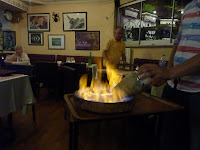We've had plain food and flashy food in Istanbul. On the whole (unlike a lot of the other tourists we assume) we tend to prefer food where the waiters do not make a big floor show, going for taste rather than flashy display, and we both hate being the centre of attention in a restaurant. In this last Turkish food blog, I'll show both the plain and the flashy food we encountered.
A tourist can eat well and cheaply if one buys food in the local markets (a lira equals about $2 AUD)
In a non tourist restaurant we had boregi (a bit greasy) with potato wedges (they love potato chips) and a mixed Turkish salad
and an egg and sausage bake.
We've had lots of bread types in Turkey. All of them have been offered free by the restaurant. We have been offered sliced breads from a Vienna-type bread loaves, pide, so called "turkish breads, and this air filled bread, lavash, which really has to be eaten hot to be at its best.
Though simple, the breads have been great for eating with mezes and mopping up gravy when there is no rice or potato, as in this peach and chicken Ottoman stew.
We had it with a baked rice pudding and a fruit plate.
We were offered bread and pickled cabbage and cucumbers and bread as our freebie appetisers:
They were a bit surprised when we only had one meze - ezme/rushed tomato salad
and a mixed Turkish salad
to start with.
We shared a mixed kofte dish, served with bulger wheat, rice and mashed potato, tomatoes and grilled chillis, with a tomato and chilliu sauce.
We found their icecreams very fancy, but they are everywhere and you can taste the fruit in them. I loved the berry ones - especially the blackberry.
The baklava are everywhere too, varied and very good:
as are Turkish delight, which taste very different when fresh and which are served in smaller portions than they are here in Australia.
In a tourist restaurant, we ordered a salt baked levrek/ sea bass. We were offered lavash, black olives and hommus
After 45 minutes, the fish came out baked in a thick crust of sauce. It proved to be one of those fancy show dishes that we try to avoid. It wasn't needed, but a show for the tourists was put on. Purple flammable liquid was poured on
and set alight.
Then, the fire was doused and the salt cracked to reveal a large fish wrapped in foil, which surprised me.
The fish was carved and them served to us. It was delicious and cooked with button mushrooms and garlic, and served with salad and baked potato. We couldn't finish it all.
Another meal that we saw in most of the tourist restaurants again involved lots of fire," testi kebap", the claypot lamb stew. Apparently the dish originated in Cappadocia, and is a lamb, vegetable and spice stew baked in a ceramic vessel shaped like an amphora and sealed with dough. To serve, the amphora, which has a groove round the neck to weaken it, is cracked and the stew poured out. The tourist restaurant pour the pre-cooked stew into the amphoras and bring them out in flaming trays.
the waiter then bangs on the groove with a metal rod until a crack appears, knowks off the lid, and pours it on the palte of the admiring diner.
We avoided this dish, pre-warned by a friendly waiter about the show, but apparently it did taste very good.
Now we are back in Australia, we are going to try our hand at cooking Turkish food, simple and fussy, but I think we'll avoid the fire show.




























No comments:
Post a Comment